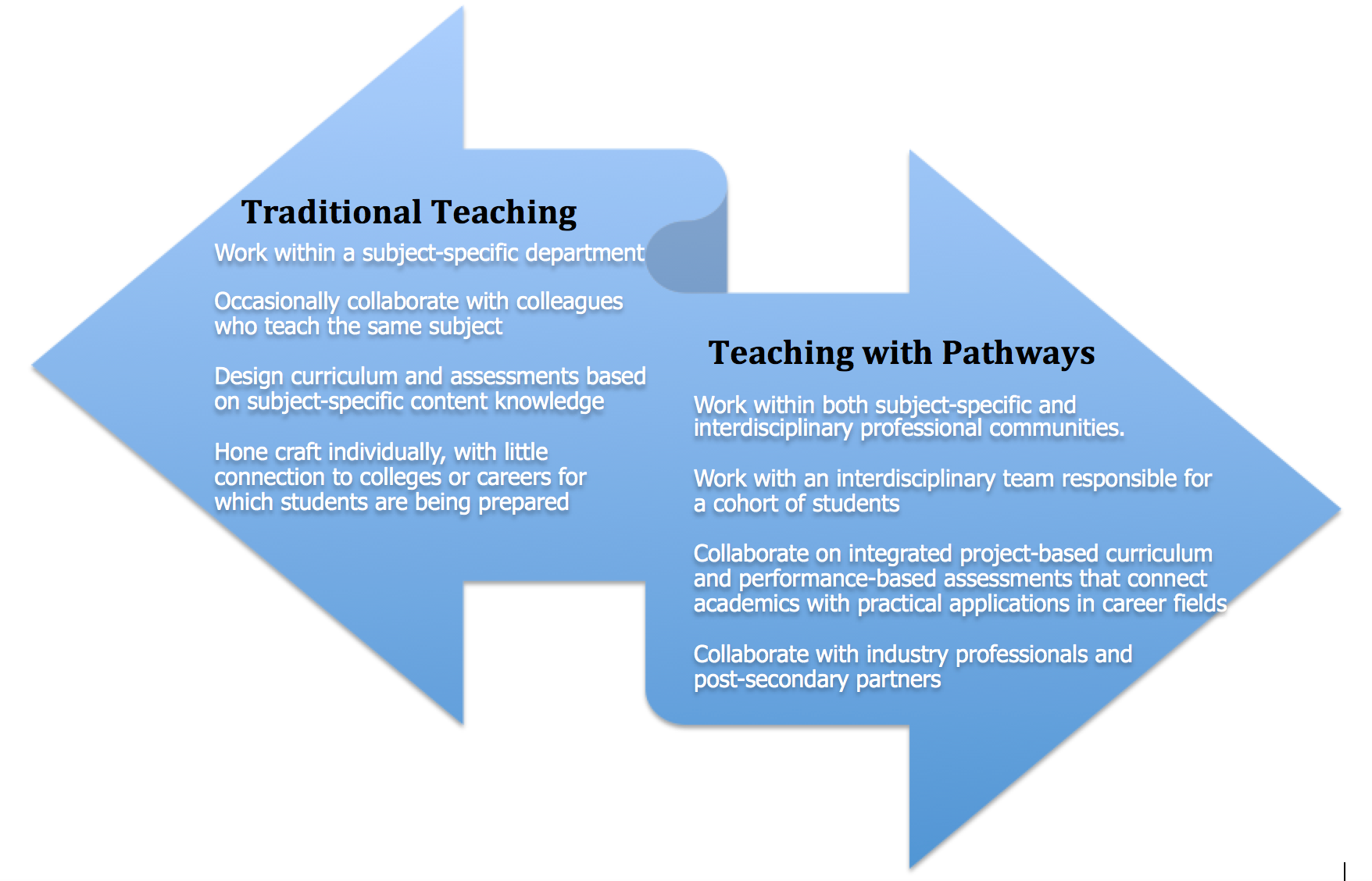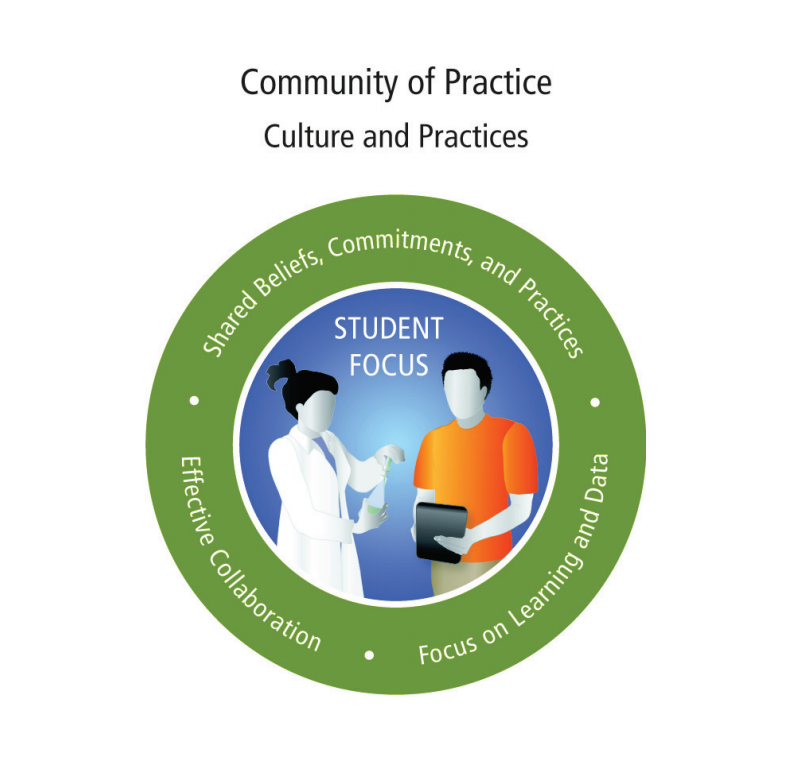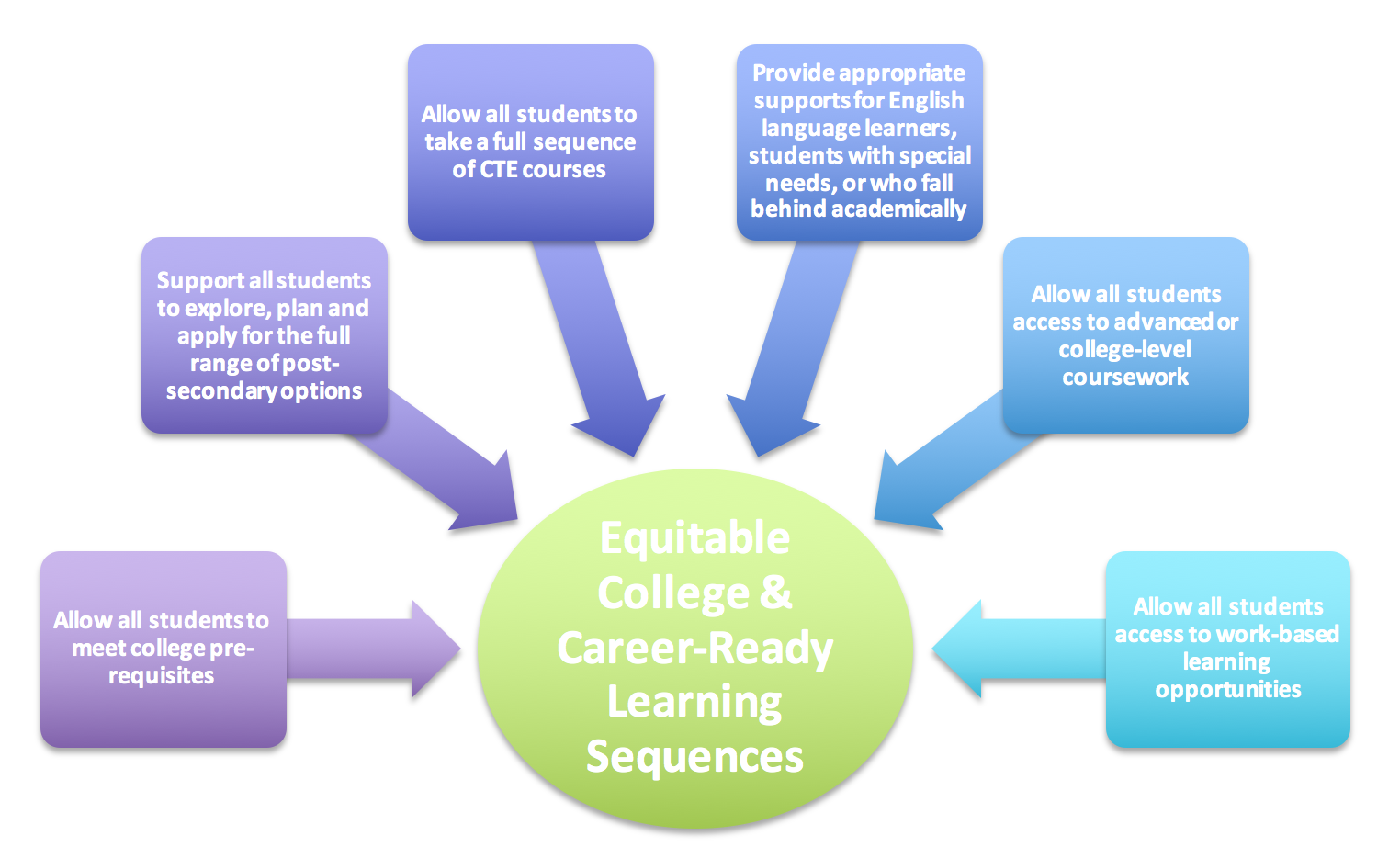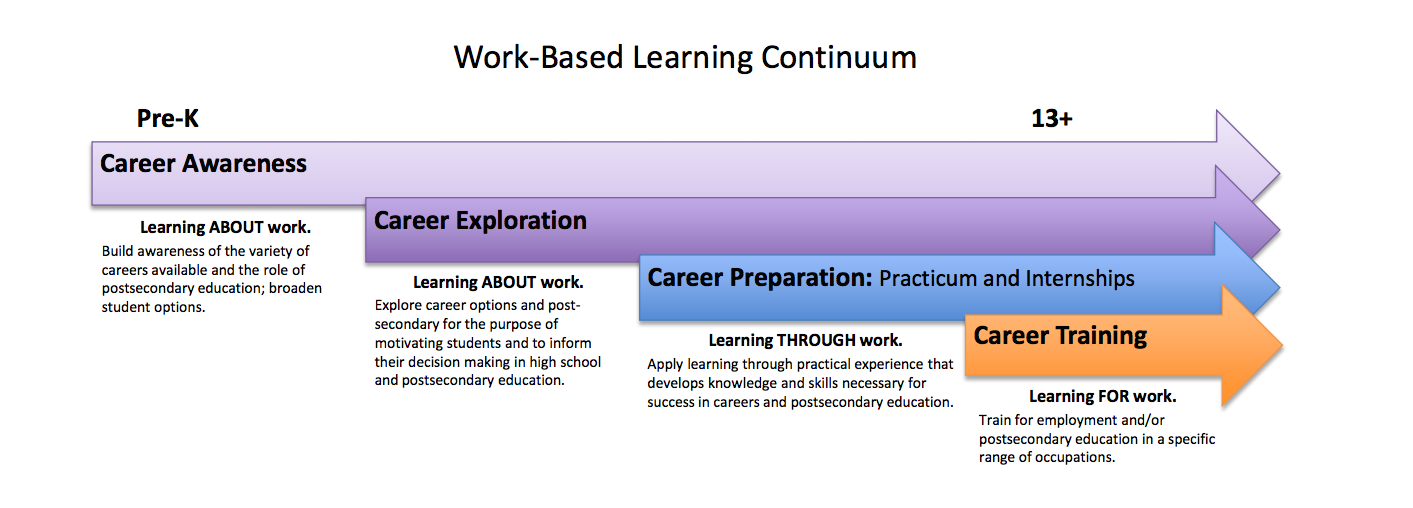College and Career Pathways Leadership Guide
Team Leaders
Teacher leaders are peer leaders, a position which enhances their potential effectiveness because it rests upon their legitimacy in the eyes of their peers, rather than the  authority of an administrative position. As pathways develop, teacher team leaders learn to work with adult learners, establish professional norms, and consider the needs of the entire school as well as those of their own pathways. They have to reach out beyond the classroom, not only to encompass the site vision, but also to bring industry and post-secondary partners into the high school context. And most importantly, they orchestrate the work of developing the team’s instructional expertise, emphasizing applications from a particular industry field using interdisciplinary, project- and problem-based strategies, as well as performance-based assessments. In each of these areas, teacher leaders need training, resources, models, and support from site and district leaders.
authority of an administrative position. As pathways develop, teacher team leaders learn to work with adult learners, establish professional norms, and consider the needs of the entire school as well as those of their own pathways. They have to reach out beyond the classroom, not only to encompass the site vision, but also to bring industry and post-secondary partners into the high school context. And most importantly, they orchestrate the work of developing the team’s instructional expertise, emphasizing applications from a particular industry field using interdisciplinary, project- and problem-based strategies, as well as performance-based assessments. In each of these areas, teacher leaders need training, resources, models, and support from site and district leaders.


Developing Team Vision, Mission and Student Outcomes: When all teachers in a pathway team share a vision of the essential student outcomes, have agreements for how they will work together toward those outcomes, and can identify benchmarks for each grade level, they can identifying the key concepts to emphasize in interdisciplinary projects, and can weigh student work against those intended outcomes to assess progress and adjust teaching. The outcomes emphasized in a health pathway are likely to be different from those emphasized in an engineering or culinary pathway. But all pathway outcomes should align to site and district graduate profiles. A sample process for developing pathway outcomes from ConnectEd is available here. An excellent activity for engaging team members in pedagogical discussion about vision and mission is available here.
Filling Open Positions in Teacher Teams: When a teaching position is open in a Linked Learning pathway, it is important that position be filled by a staff member who is interested in the pathway industry sector and in being part of a highly collaborative community of practice. Seeking out such teachers may be difficult for a pathway lead, and is best done in collaboration with a site administrator. For example, all teachers in a department could be invited to a meeting with pathway representatives to discuss the expectations and advantages of working with a pathway team, and to solicit interest prior to a school-wide poll of teachers’ preferences for the coming year.
Induction Processes: As Linked Learning pathway communities of practice develop, it will be important to clearly define teacher team members’ discrete roles and responsibilities. An annual review of leadership responsibilities within the team encourages teachers to exert leadership in an area of strength, such as student leadership development, or managing field trips and college visits, but also introduces new teachers to team agreements that define how those things are done. Some of important on-boarding information might include pathway policies about: student learning outcomes, collaboration norms, teachers’ collective responsibility to chaperone off-site work based learning experiences, the purpose and process for implementing integrated curriculum, recruitment and selection of students, and common classroom policies, routines and expectations.
Community Agreements: Because teachers often work in isolation, it is very useful to develop explicit expectations for how teachers on a team desire to work together. Such agreements, if commonly valued and regularly referenced, can increase the productivity of teacher collaboration time dramatically. They remind teachers that they value each other’s time, and keep them focused on what they plan to do together. They set parameters on conflict, and allow it to be respectful and productive. Such agreements are essential to creating spaces where people can take risks, learn from their mistakes, and grow as professionals. See sample community agreements here.
Professional norms: Creating a safe and supportive team context for collaboration also includes involving teachers in decisionmaking, such as collaborative planning for team meetings, and collaborative decisionmaking about how to build the pathway. Creating an outcome-based agenda provides clear goals for collaboration, and accountability for group decisions. A template for such an outcome-based agenda is available here. Additionally, there should always be clearly defined roles within a collaborative group: for example, note-taker, time-keeper, facilitator, host, process-checker or next-stepper. This structure creates internal accountability that is far more effective than the traditional administrative regulation of teachers’ professional learning. Through school-wide inclusive leadership bodies, teacher leaders should be supported to develop group facilitation and leadership development skills. A useful resource for introducing facilitation skills can be found here.

New Instructional Practices: A pathway team leader facilitates the team’s professional collaboration around interdisciplinary, Common Core and NGSS aligned, industry-involved, project and problem-based curriculum, and performance-based assessments. Collaboratively creating curriculum and common assessments allows teachers to share their disciplinary knowledge and explore new instructional practices. An example how to use the Behaviors of Learning and Teaching Continuum during informal, non-evaluative instructional rounds or class walkthroughs can be found HERE.
Integrating academic and career technical content: Practical applications from a career field of interest to students can contextualize academic learning, and increase student motivation, engagement and learning. Linked Learning offers tools, training and support for pathway teams to address new state standards while building college and career pathways to improve student success. When teachers are able to investigate the sources of students’ progress or difficulties, and collaborate to address them, instruction is far more effective. When done as a formative process, teachers can address the difficulties students are experiencing before a final, summative assessment is conducted.
Often teachers need to learn about the career field in order to engage students with practical applications of academic content from the career field. Teacher externships are an essential professional development experience for teachers who are expected to contextualize their subject matter using the standards and performance tasks applicable from a specific career field. Teachers with both subject matter and industry experience are extremely valuable to pathway teams, and become leaders in developing the teams’ capacity to pose performance tasks and develop interdisciplinary performance assessments. An example of how a district develops dual academic and CTE expertise can be found here.
Outcome-based planning: In order to have these conversations about the problems that arise in teaching practice, the teacher team needs a collective vision of what they expect students to learn. The Instructional Design and Revision Cycle illustrated below is described in ConnectEd’s Community of Practice Continuum, which supports teacher teams to align their collaborative work on instruction with the outcomes defined by their team, the career pathway, postsecondary partners, their district, and state. They can design curriculum, and weigh student work against those expected learning outcomes.

Planning Resources: ConnectEd has developed a number of tools for creating pathway outcomes and backwards mapping them to identify key benchmarks for each grade level, which can guide the development of interdisciplinary projects. Outcome mapping is an essential preliminary step that should be accomplished in the planning phase, because it informs curriculum development. In depth discussion about how to assess student work relative to those outcomes can be facilitated through the development of common rubrics, which gets all teachers on the same page and provides a means to integrate Common Core implementation with pathway development. ConnectEd Studios has excellent resources for creating outcome-based and Common Core aligned performance tasks and assessments.
A program of study is:
- A document that outlines a series of courses that incorporates and aligns high school and postsecondary.
- Integrates academic and career technical content in a coordinated progression of non-duplicative courses in an industry sector.
- Offers opportunity for high school students to acquire postsecondary credits.
- Leads to an industry recognized credential or certificate at the postsecondary level, or an associate or baccalaureate degree.
For a College and Career Academy, a Program of Study also:
- Integrates academic and technical curriculum through interdisciplinary projects, work-based learning and performance assessments.
- Provides support services necessary to ensure all students are successful.
- Includes strong and sustained partnerships with business, community and other stakeholders.
- Incorporates career guidance and mentoring opportunities.
A coherent program of study progresses developmentally – that is, it builds on the natural development of youth to adulthood, supporting young people to explore their interests and build their capacities with constant access to career information and work-related experiences. This increases the relevance of academic study, and motivates students. Research into how people learn indicates that the more academic concepts are embedded in real world contexts and problems, the more easily students learn, particularly if the contexts and problems are relevant to their own lives.
An equitable program of study ensures that all students, regardless of wealth, heritage, or previous academic experience, have access to the supports, courses, teachers, and resources they need to achieve their career goals. This means making sure all students have access to BOTH college and career preparation. Where high schools have historically divided student into “tracks,” which determine students’ post-secondary options, this can be difficult. Most often that filtering process recreates social inequities. Students who enter the education system with more resources – whether cultural or material – are far more likely to be successful in it. One of the ways a career pathway counteracts that pattern is by ensuring that all students have access to and support to be successful in a program of study that prepares them for all post-secondary options.
A Coherent, Equitable Program of Study Supports ALL Students:
- To meet college prerequisites.
- To take a full sequence of CTE courses.
- To get appropriate supports for ELD, special needs, or remediation.
- To access both advanced coursework and work-based learning.
- To explore, plan and apply for the full range of post-secondary opportunities.
The high school program of study looks somewhat different from the college program of study, with an emphasis on:
- identifying all classes students take in the pathway
- classes that are cohorted and integrated
- work-based learning opportunities
- student support programs
Pathway teams annually use a template like this one to review their course sequences, including:
- the academic courses that contextualize instruction
- the general education courses required for graduation
- advanced coursework options (such as dual enrollment or AP courses)
This often entails course development, which requires time and sometimes additional support, and must fit with school master scheduling processes.

Review completed Program of Study templates for each pathway on a site to assess the extent to which they meet these six criteria for equitable access to learning opportunities. Prioritize changing pathway courses so that all students at the school have equitable access to learning opportunities no matter their Program of Study. See some options here.
Integrating work-based learning into classroom instruction enriches and deepens student engagement with both technical skills and academic content. Career pathways teacher teams collaboratively define the academic, career technical, and career readiness outcomes they want to address through work-based learning, then plan a coherent sequence of high intensity experiences throughout their program. As you can see in the graphic below, there are a wide range of experiences that can be used to achieve those outcomes.
Basic Principles:
- Outcome-based planning by whole team (academic and CTE teachers)
- Employer-involved planning, implementation, and assessment
- Embedded in classroom instruction
- Accessible to all students, regardless of wealth, heritage, or previous academic experience
Career readiness curriculum is readily available, and links are provided on the CCASN website under CCASN Library/Instructional Resources. Resources for organizing many activities related to work-based learning are available in CCASN Toolbox/Work-Based Learning. Oakland Unified School District developed an excellent set of one-page descriptions of key activity outcomes and criteria, for pathway teachers to use in planning work-based learning activities, available here.

